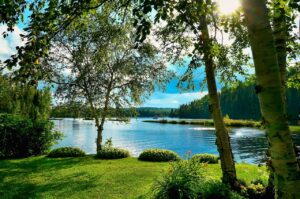
What exactly is biodiversity?
Biodiversity is the diversity within species, between species and of ecosystems. It is declining globally, faster than at any other time in human history.
The world’s 7.6 billion people represent just 0.01% of all living things by weight, but humanity has caused the loss of 83% of all wild mammals and half of all plants.
Biodiversity loss and ecosystem collapse is one of the top five risks in the World Economic Forum’s 2020 Global Risks Report, too.
How biodiversity can help our health
Higher rates of biodiversity have been linked to an increase in health.
Plants are essential for medicines: 25% of drugs used in modern medicine are derived from rainforest plants, while 70% of cancer drugs are natural or synthetic products inspired by nature. This means that every time a species goes extinct, we miss out on a potential new medicine.
Biodiversity due to protected natural areas has been linked to lower instances of disease such as Lyme disease and malaria.
While the exact origin of the virus causing COVID-19 is still unknown, 60% of infectious diseases originate from animals and 70% of emerging infectious diseases originate from wildlife.
As human activities encroach upon the natural world - through deforestation and urbanisation - we reduce the size and number of ecosystems. As a result, animals live in closer quarters with one another and with humans, creating ideal conditions for the spread of zoonotic diseases.
What we can do to promote local biodiversity
Biodiversity covers the local ecosystems that promote healthy conditions for organisms to thrive in. To promote and preserve local biodiversity we can all:
1 - Support local farms
Regularly buying from small local farmers at stands or markets helps to support agricultural efforts to conserve biodiversity. Buying ‘organic’ is ideal for us and for the planet, but farmers who practice ‘Integrated Pest Management’ can offer high quality products with nearly no chemical intervention.
2 - Save the bees!
Bees are important to preserving biodiversity – and they are increasingly under attack from varroa mites. You can help save them by planting nectar-producing wildflowers in your garden, or even building bee boxes for local bees to call home. (Always be mindful about the products you use in the garden, as standard pesticides can be harmful or deadly to bees).
3 - Plant native flowers and scatter native seeds
You could plant a variety of native flora in your garden, or use a hanging basket. Support local nurseries that specialise in native species. Nurseries can be great sources of information about plant maintenance and care. They should also be able to tell you where they source their plants from - the more local, the better.
By supporting local wildlife, you’re helping to preserve the biodiversity of your area and support its local ecosystem.
4 - Take shorter showers
Biodiversity depends on the abundance of local fresh water. Taking five-minute showers and turning the water off while washing your hands, doing the dishes, or brushing your teeth are all easy ways to conserve water.
5 - Respect local habitats
Plants growing in the parks and woodlands near you often play an important role in preserving the local ecosystem. When you’re outdoors, protect local biodiversity by sticking to the walking path or hiking trail. Help and encourage your children and pets to do the same.
6 – Know the source
Check that the companies you purchase goods from are not contributing to the destruction of habitat. Look for labels such as FSC (Forest Stewardship Council) or Rainforest Alliance Certified. Both organisations are committed to the conservation of the Earth’s resources, and they also advocate for the human rights of native peoples.
We all need to act now
The clearance of over 35% of the world’s mangroves for human activities has increasingly put people and their homes at risk from floods and sea-level rise. If today’s mangroves were lost, 18 million more people would be flooded every year (an increase of 39%) and annual damages to property would increase by 16% (billion). Protecting and restoring natural ecosystems is vital to fighting climate change. Nature-based solutions could provide 37% of the cost-effective CO2 mitigation needed by 2030 to maintain global warming within 2°C (35.6 F).
Ultimately, spending more time in nature can help improve our relationship with it. Also, educating children about wildlife and local ecosystems can help to make our connection to the natural world clearer - and bring about long-term behavioural changes for future generations.
Carl Dodd, Property Revolutions Ltd.

